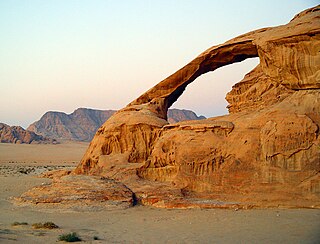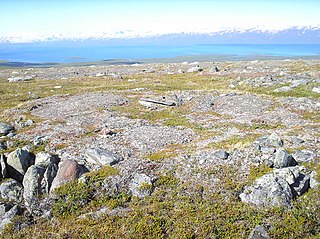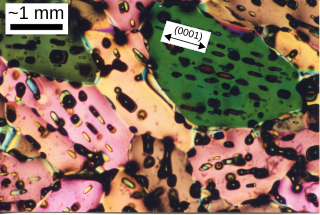
Landslides, also known as landslips, are several forms of mass wasting that may include a wide range of ground movements, such as rockfalls, mudflows, shallow or deep-seated slope failures and debris flows. Landslides occur in a variety of environments, characterized by either steep or gentle slope gradients, from mountain ranges to coastal cliffs or even underwater, in which case they are called submarine landslides.

Weathering is the deterioration of rocks, soils and minerals through contact with water, atmospheric gases, sunlight, and biological organisms. Weathering occurs in situ, and so is distinct from erosion, which involves the transport of rocks and minerals by agents such as water, ice, snow, wind, waves and gravity.

Freezing is a phase transition where a liquid turns into a solid when its temperature is lowered below its freezing point. In accordance with the internationally established definition, freezing means the solidification phase change of a liquid or the liquid content of a substance, usually due to cooling.

Scree is a collection of broken rock fragments at the base of a cliff or other steep rocky mass that has accumulated through periodic rockfall. Landforms associated with these materials are often called talus deposits. Talus deposits typically have a concave upwards form, where the maximum inclination corresponds to the angle of repose of the mean debris particle size. The exact definition of scree in the primary literature is somewhat relaxed, and it often overlaps with both talus and colluvium.

Frost heaving is an upwards swelling of soil during freezing conditions caused by an increasing presence of ice as it grows towards the surface, upwards from the depth in the soil where freezing temperatures have penetrated into the soil. Ice growth requires a water supply that delivers water to the freezing front via capillary action in certain soils. The weight of overlying soil restrains vertical growth of the ice and can promote the formation of lens-shaped areas of ice within the soil. Yet the force of one or more growing ice lenses is sufficient to lift a layer of soil, as much as 1 foot or more. The soil through which water passes to feed the formation of ice lenses must be sufficiently porous to allow capillary action, yet not so porous as to break capillary continuity. Such soil is referred to as "frost susceptible". The growth of ice lenses continually consumes the rising water at the freezing front. Differential frost heaving can crack road surfaces—contributing to springtime pothole formation—and damage building foundations. Frost heaves may occur in mechanically refrigerated cold-storage buildings and ice rinks.

Pingos are intrapermafrost ice-cored hills, 3–70 m (10–230 ft) high and 30–1,000 m (98–3,281 ft) in diameter. They are typically conical in shape and grow and persist only in permafrost environments, such as the Arctic and subarctic. A pingo is a periglacial landform, which is defined as a non-glacial landform or process linked to colder climates. It is estimated that there are more than 11,000 pingos on Earth. The Tuktoyaktuk peninsula area has the greatest concentration of pingos in the world with a total of 1,350 pingos. There is currently remarkably limited data on pingos.

An ice shove is a surge of ice from an ocean or large lake onto the shore. Ice shoves are caused by ocean currents, strong winds, or temperature differences pushing ice onto the shore, creating piles up to 12 metres high. Ice shoves can be caused by temperature fluctuations, wind action, or changing water levels and can cause devastation to coastal Arctic communities. Cyclical climate change will also play a role in the formation and frequency of ice shove events; a rise in global temperatures leads to more open water to facilitate ice movement. Low pressure systems will destabilize ice sheets and send them shoreward. Also referred to as "landfast ice", it is an essential component to the coastal sea ice system, including the sediment dynamics. Arctic peoples utilize these ice shoves to travel and hunt. Ringed seals, an important prey for polar bears, are specifically adapted to maintain breathing holes in ice shoves, which lack the same openings usually used by marine mammals in drifting ice packs. The mere fact that the Ringed seal is uniquely adapted to utilizing ice shoves for breathing holes, and that polar bears have adapted to this behaviour for hunting, as well as the fact that the Inupiat have a distinct term for the phenomena, indicates that ice shoves are a regular and continuing phenomena in the Arctic.
In fluid statics, capillary pressure is the pressure between two immiscible fluids in a thin tube, resulting from the interactions of forces between the fluids and solid walls of the tube. Capillary pressure can serve as both an opposing or driving force for fluid transport and is a significant property for research and industrial purposes. It is also observed in natural phenomena.

The surface color of the planet Mars appears reddish from a distance because of rusty atmospheric dust. From close up, it looks more of a butterscotch, and other common surface colors include golden, brown, tan, and greenish, depending on minerals.

Ice sheet dynamics describe the motion within large bodies of ice such as those currently on Greenland and Antarctica. Ice motion is dominated by the movement of glaciers, whose gravity-driven activity is controlled by two main variable factors: the temperature and the strength of their bases. A number of processes alter these two factors, resulting in cyclic surges of activity interspersed with longer periods of inactivity, on both hourly and centennial time scales. Ice-sheet dynamics are of interest in modelling future sea level rise.
Ice jacking occurs when water permeates a confined space within a structural support or a geological formation, ultimately causing structural fracture when the water freezes and expands. The force from this expansion can damage shorelines, rock faces, and other natural environments. This has the potential to lead to property damage and environmental changes. Ice jacking most commonly refers to shoreline damage caused by lakes freezing, but it has also been applied to geologic engineering and rock erosion. When this occurs within rocks, it is called ice wedging. When this occurs within the soil, it is called frost heaving or ice heaving. It is similar in appearance to, but not to be confused with, ice shove, which is a pile-up of ice on a shoreline.

A frost boil, also known as mud boils, a stony earth circles, frost scars, or mud circles, are small circular mounds of fresh soil material formed by frost action and cryoturbation. They are found typically found in periglacial or alpine environments where permafrost is present, and may damage roads and other man-made structures. They are typically 1 to 3 metres in diameter.

Ice lenses are bodies of ice formed when moisture, diffused within soil or rock, accumulates in a localized zone. The ice initially accumulates within small collocated pores or pre-existing crack, and, as long as the conditions remain favorable, continues to collect in the ice layer or ice lens, wedging the soil or rock apart. Ice lenses grow parallel to the surface and several centimeters to several decimeters deep in the soil or rock. Studies from 1990 have demonstrated that rock fracture by ice segregation is a more effective weathering process than the freeze-thaw process which older texts proposed.

Frost flowers are ice crystals commonly found growing on young sea ice and thin lake ice in cold, calm conditions. The ice crystals are similar to hoar frost, and are commonly seen to grow in patches around 3–4 cm in diameter. Frost flowers growing on sea ice have extremely high salinities and concentrations of other sea water chemicals and, because of their high surface area, are efficient releasers of these chemicals into the atmosphere.
Cryosuction is the concept of negative pressure in freezing liquids so that more liquid is sucked into the freezing zone. In soil, the transformation of liquid water to ice in the soil pores causes water to migrate through soil pores to the freezing zone through capillary action.

Sea ice is a complex composite composed primarily of pure ice in various states of crystallization, but including air bubbles and pockets of brine. Understanding its growth processes is important for climate modellers and remote sensing specialists, since the composition and microstructural properties of the ice affect how it reflects or absorbs sunlight.

Ice segregation is the geological phenomenon produced by the formation of ice lenses, which induce erosion when moisture, diffused within soil or rock, accumulates in a localized zone. The ice initially accumulates within small collocated pores or pre-existing cracks, and, as long as the conditions remain favorable, continues to collect in the ice layer or ice lens, wedging the soil or rock apart. Ice lenses grow parallel to the surface and several centimeters to several decimeters deep in the soil or rock. Studies between 1990 and present have demonstrated that rock fracture by ice segregation is a more effective weathering process than the freeze-thaw process which older texts proposed.
Brine rejection is a process that occurs when salty water freezes. The salts do not fit in the crystal structure of water ice, so the salt is expelled.
Frost damage is caused by moisture freezing in the construction. Frost damage can occur as cracks, stone splinters and swelling of the material.
J. Gregory Dash (1923–2010) was a physics professor, known for his research on superfluidity, adsorption of gases on smooth surfaces, surface melting, and films on solid surfaces.














